By Jessalyn Bachler
In this article of the Poisonous Plants on Rangelands series, plants that are found in disturbed areas will be reviewed. Several species of poisonous plants are invasive and can easily establish dense stands when there is a disturbance on rangelands. Hemlocks, halogeton and buffalo bur can all be found throughout South Dakota and are toxic to livestock.
Hemlocks
Hemlocks belong to the carrot family and are biennial plants, characterized by having small leaves with five petals and compound umbels. Water and poison hemlock are the two species found throughout rangelands in South Dakota. Both are extremely poisonous to livestock and humans alike, making proper identification crucial.
WATER HEMLOCK
Water hemlock (also known as spotted water hemlock) (Figure 1) has alternate, bi-or tri-pinnate leaves that are 4 ½ inches in maximum length and strongly veined with serrated edges. The plant has large, green, hollow stems, with the lower portion being purplish and an umbel inflorescence that looks like an umbrella composed of five petaled, tiny white flowers.
Water hemlock is found across South Dakota in water-filled sites, such as riparian areas, wet meadows and ditches or springs.
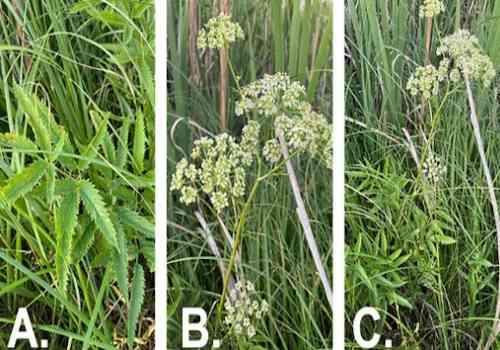
Figure 1. Water hemlock seen in a riparian area on a South Dakota rangeland. A) Note the large, pinnate leaves that are sharply serrated. B) The white umbrel inflorescence. C) Leaves and inflorescence together.
POISON HEMLOCK
Poison hemlock (also known as deadly hemlock) (Figure 2) prefers drier, disturbed sites, including pens and manure piles, cultivated fields and gardens, ditches and fence lines or wet areas that dry up in late summer.
Although it can sporadically be found across South Dakota, poison hemlock is commonly found throughout the Black Hills region. It is identified by large, compound leaves that resemble parsley and hollow, pale-green stems with purple spots and a flattened, white umbel inflorescence.
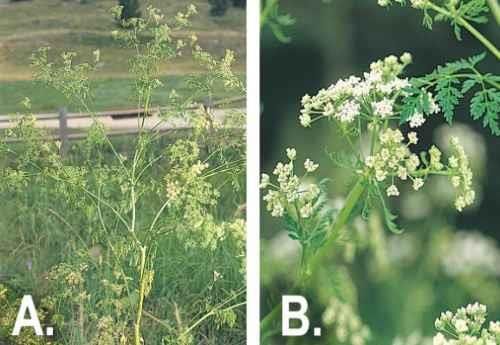
Figure 2. Poison hemlock. A) Note the flattened, white umbel inflorescence. B) Small, compound leaves next to the umbel.
Poisoning from hemlocks is caused by ingestion of any part of the plant, especially the roots, seeds, young leaves and new shoots due to harmful alkaloid compounds. Livestock will generally not graze hemlocks if adequate forage is available. Symptoms of hemlock poisoning include trembling, loss of coordination, dilated pupils, weakened heartbeat, come and sudden death caused by respiratory failure. There is no treatment or cure for hemlock poisoning, as effects are often rapidly fatal. Water hemlock is regarded as the most violently poisonous plant in North America.
Both species of hemlock have commonly been mistaken for wild parsnip and caused poisoning in humans. Wild parsnip, another toxic plant, can be identified apart by its bright-yellow umbel seed head and much broader leaves than the hemlocks (Figure 3).
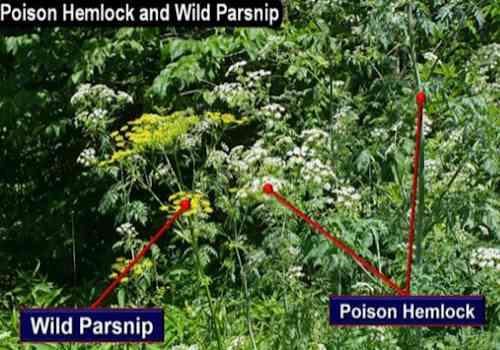
Figure 3. Wild parsnip and poison hemlock. Note the difference in umbel color and leaf shape.
Halogeton
Halogeton (Figure 4) has small, alternate, blueish-green leaves that are succulent-like with a short bristle at the end and curved, reddish-pink stems that branch from the base of the plant. When halogeton flowers, as shown in Figure 4, very small greenish-yellow sepals become present with the highly visible bright reddish-pink stem attachments across the entire plant. Halogeton is reported to be an invasive plant in Badlands National Park in South Dakota and can be found elsewhere throughout the southwestern part of the state. Arid regions with alkaline soils and disturbed sites are the most-common ecosystems where halogeton will thrive.
Halogeton accumulates salts, including toxic amounts of sodium oxalates that make it fatal to livestock, especially sheep. Livestock will readily graze the plant when it is mature. Symptoms of livestock poisoning from halogeton will appear two tosix hours after ingestion and will include weakness, shallow breathing, coma and eventual death from kidney failure. Proper control of halogeton is critical but is also difficult, as each plant produces large numbers of seed that can survive in the soil for 10 years or more. Plants can be controlled with proper use of herbicides, with small infestations eradicated if treated early. Specifically, 2,4-D will kill over 95% when applied in late-May or early-June, but it is not selective. Instead, several steps can be taken to prevent halogeton poisoning, such as maintaining rangelands that support adequate forage, provide supplemental feed when animals trail or graze through an infested area, and preventing animals from becoming hungry or thirsty while grazing areas that are infested with halogeton, as they graze indiscriminately.
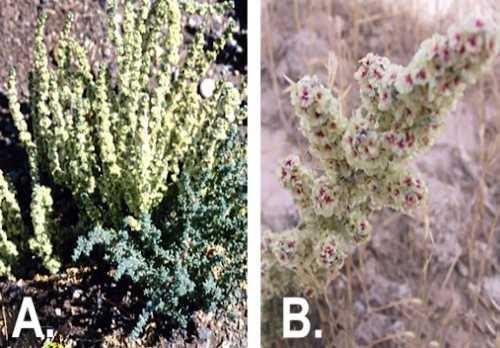
Figure 4. A) Halogeton plant that is starting to flower. Courtesy: Colorado State University. B) Halogeton in flower. Courtesy: Scott Mincemoyer, Montana Field Guide, MT.GOV.
Buffalo Bur
Buffalo bur (also known as prickly nightshade) (Figure 5) has many bright-yellow, five-petaled flowers that blossom all summer, along with spiny thorns covering the plant and deep-green, alternate, round-lobed leaves. The plant has “burs” that are covered in spines and contain a berry. Buffalo bur is found across South Dakota in disturbed areas, such as ditches, cultivated lands, feedlots, depleted rangelands and on sandy sites, including river bottoms. It is a very drought-tolerant plant and is seen in abundant stands during dry years.
Like other members of the nightshade family (Solanaceae), buffalo bur contains toxic alkaloids. If the leaves or berries are ingested, a dose as small as 0.1–0.3% of body weight can be lethal for cattle. Sheep and goats are less susceptible to be poisoned by the plant. Livestock are generally discouraged to eat buffalo bur due to its spiny thorns; however, producers should be cautious of grazing an area if it is abundant and the only plant available to be grazed.
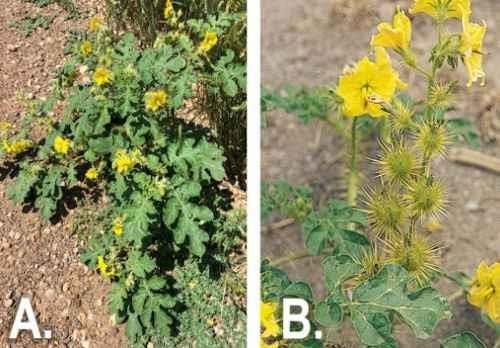
Figure 5. A) Buffalo bur seen along a roadside ditch on a South Dakota rangeland. Courtesy: Jessalyn Bachler. B) Flower and bur profile.
Source : sdstate.edu